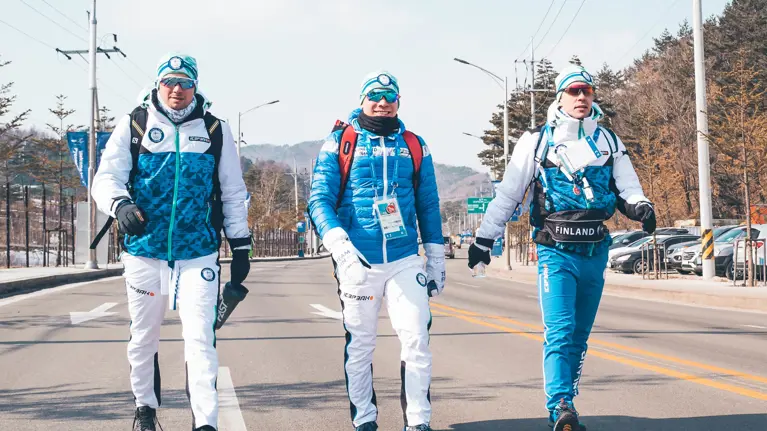
Healthy training days are a key to success
How can data help in this?
Published: 23 May 2022
Injured knee, broken ankle or strained quads? When competing at elite level, strains and injuries can ruin your whole competition season. What kind of measures do athletes’ support teams take to steer clear from sports injuries? How can you benefit from coaching data?
Marko Rossi, who is a sports physiotherapist with a Master’s degree in Health Sciences, was a happy man after the Cross-Country Skiing Finnish Championships that took place in Imatra recently. Several athletes whose early season had been overshadowed by injury and physical challenges triumphed at the championship events. Rossi participated in the rehabilitation of the skiers.

Working as a physiotherapist with the Finnish Cross-Country National Team and the Vuokatti-Ruka Olympic Training Centre, Rossi has engaged in the training and rehabilitation of a number of athletes. His work focuses primarily on injury prevention.
“Physiotherapy has become an integral part of coaching. The more we know about different types of challenges and risk factors, the better we are capable of steering training to a direction of the athlete having a maximum number of healthy training days.
We do a lot of preventive work, which means that we can stop injuries before they happen. The monitoring of training load is in a key role, but sufficient strength training and things like activating warm-up moves before training are similarly important.”
Data helps rehabilitation
Rossi says that strain injuries can occur from a wide range of reasons.
“They can result from the athlete’s endurance, strength or mobility not being up to par with their training load, for example. This is also typical to young athletes whose training programme is excessively sport-specific without other exercise that would contribute to their versatile development.”
“There are usually several reasons behind a strain injury. The relevance of the contributory factors varies greatly from athlete to athlete. The athlete’s total load, their alertness, psychosocial factors, any previous injuries, their diet, and so forth. If the challenge lies with the athlete’s nutrition, it cannot be solved with physiotherapy. The tiniest details can become crucial in elite sports.”
“These days, we have a lot of research data on various risk factors. They cover topics such as body proportions, oxygen uptake, differences in body halves. Health data is one part of the puzzle, and training data another.”
According to Rossi, the best initial situation in training is for the coach to know the athlete well, the athlete being able to understand their body needs, and health data and training data available from various sources. In these circumstances, you can make analysis and compare results with older data. If there is an injury, data helps with rehabilitation.”
“When data is available of the pre-injury performance level and physical attributes, data can be used to determine the safe level of training in the rehabilitation phase, and how to proceed with increasing the training load. With annual tests using the same criteria and variables, more data is constantly collected. With sufficient accumulated data, you can examine trends, prepare multivariate analysis and find out if athletes are predisposed to certain risks of illness or injury. The data can help a coach to react proactively in situations of excessive load, for instance.”
Athlete’s feelings count
The Vuokatti-Ruka Olympic Centre is a training centre for snow sports, and the athletes and coaches are supported by a multi-professional network. Experts in sports medicine, sports physiotherapy, sports physiology, physical and mental coaching are closely involved in the day-to-day activities of the training groups.
The data project, a collaboration of the Olympic Committee and Tietoevry, introduces a system solution that provides sport-specific data to benefit the support organisation. The data can be used to improve training and to respond to changes in the athlete's wellbeing during the training season.
In addition to the importance of the athlete’s own sensations, Matti Partanen, Tietoevry Product Lead, emphasizes the athlete’s own interest in data.

“You sometimes hear people say that you can’t trust a feeling, you need hard data. The athlete’s own feelings are still in a major role. When you combine their sensations with the data from the sensors, you can form a more detailed overall picture of the athlete’s situation than by using sensor data alone.”
“More experienced athletes are usually better at listening to their bodies than younger ones. Data gives athletes the opportunity to learn to interpret their own sensations faster. This requires that both the athlete and coach show an interest in monitoring data and making notes of it. This will help the athlete to form a personal databank that makes it possible for the athlete and those examining the data to predict if the athlete is at risk of becoming ill or injured.
Athletes do not have to learn everything the hard way, because their support organisation has access to research data on elite sports,” says Partanen.
“Research shows that, in addition to insufficient or excessive training load, the injury risk also increases significantly if the training volume increases at a very fast pace. This is typical to recreational athletes who get carried away when they start exercising, but the training programme of top athletes also has to be amended at times, for example due to illness. The data provides a tool for training load customisation in specific situations like these.”
Wellbeing data helps to achieve healthy training days
The 360° Training and Wellbeing app, developed by Tietoevry, provides sports organisations as well as health and social care providers an easy-to-use tool that saves time and money by monitoring and analysing wellbeing data at individual and groups level.
“The application combines data from multiple sensors with application survey data collected from athletes. The support organisation can get a quick, up-to-date overview instead of having to access several systems to retrieve pieces of information. Athletes often rely on their coach to keep an eye on the development of the load. When one coach works with several athletes, and their time is limited, the app saves the coach’s time,” concludes Partanen.
“Now the app ensures that the whole support organisation can obtain information of all the athletes in a training group, including athlete load and health, without delay. Adequately systematic data monitoring can help to prevent the occurrence of sport injuries in many cases. Recovery is often time-consuming, which means that monitoring wellbeing data pays for itself in the form of healthy training days. They are invaluable for both athletes and their coaches.”
Read how data is part of the daily life of top athlete
The Finnish Olympic Committee: Supporting elite sport coaching with data management
